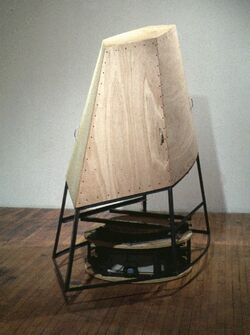Biography:Norman White
Norman White | |
|---|---|
 Norman White | |
| Born | Norman T. White January 7, 1938 San Antonio, Texas, United States |
| Nationality | Canadian |
| Education | Harvard University |
| Known for | Electronic Media Artist, sculptor, Educator |
| Movement | New Media |
Norman White (born January 7, 1938, San Antonio Texas) Canadian New Media artist considered to be a pioneer in the use of electronic technology and robotics in art.[1][2][3]
Life
White was born in San Antonio Texas in 1938.[4] He grew up in and around Boston, Massachusetts, and obtained his B.A. in Biology from Harvard University in 1959.[5] Originally planning to become a fisheries biologist, White changed his mind and decided to travel to places like New York City, San Francisco, London, and the Middle East during the 1960s.[6]
While living in San Francisco, he worked as an electrician at Hunter's Point Naval Shipyard, and developed a fascination for electrical switching systems.[7][8] In London England, 1965-1967, he began to experiment with electronics. He then moved to Toronto, Ontario, Canada, where he began creating a series of kinetic, digital logic driven light machines. His first artwork utilizing "RTL" integrated circuits was shown in the E.A.T. sponsored group exhibition entitled "Some More Beginnings", in 1969, at the Brooklyn Museum. From 1978 to 2003. White taught classes such as "Mechanics for Real Time Sculpture" as part of the Integrated Media Program of the Ontario College of Art & Design[9][10]
A retrospective of his work and influence, called Norm’s Robots and Machine Life, with works by both White and several Canadian artists he has influenced, was shown at the Agnes Etherington Art Centre, Kingston, Ontario in 2004.[8]
From 1992 to 2003, White was an essential force behind the OCAD Sumo Robot Challenge, an annual competition akin to an automaton Olympics.
From 2003 to 2016 , White taught in the Radio Television Arts Department of Ryerson University, Toronto, Ontario. He retired from teaching in 2016.
Work
Early light works
White's early electronic art consisted mostly of gridded installations of light bulbs controlled by contemporary-vintage digital logic circuits. Like most of his art, these displays were concerned more with communicating internal rules and behaviours than simple visual appeal. For example, White's first major electronic work, "First Tighten Up on the Drums" (1969),[11][12] generated shimmering light patterns through the unpredictable interaction of many interconnected circuits computing simple logical questions independently. The work illustrated how complex behaviours - for example, patterns akin to swirling clouds or rain on a window pane - can emerge from simple principles.[13] In retrospect, White recognizes this first project as an early cellular automata experiment.[14] He constructed approximately a dozen similar light machines during the early 1970s, culminating in "Splish Splash 2" (1975), a large light mural commissioned for the Canadian Broadcasting Corporation's Vancouver offices.[15]
Computer-based and robotic works
Following the purchase of his first computer, a Motorola D-1, in 1976,[4] White refocused his attention on the emerging field of robotics, and during the mid- to late-1970s began making interactive machines whose internal logic expressed itself primarily through motion. "Menage" (1974) was White's first robotic work, and again demonstrated his interest in exploring complex behaviours generated from simple principles.[16] Four robots mounted upon ceiling tracks were fitted with photo-sensitive scanners and programmed to recognize and react to light sources mounted on the other robots. The machines competed for one another's attention as they moved automatically along the overhead tracks.[17]
Subsequent robotic projects have included: "Facing Out Laying Low" (1977),[18]Cite error: Closing </ref> missing for <ref> tag[19] Over time, the voice slowly changes to a more forceful, commanding tone, complaining when the interaction is not being completed properly.[20][3]
Collections
White's work is included in the permanent collection of the National Gallery of Canada.[21][22]
Awards
Norm White was awarded for a lifetime of innovation in art with the 2018 Digifest Media Pioneer Award. He was the prize winner of the d.velop digital art award [ddaa] in 2008.[23] He won the 1995 Petro Canada Award. In 1990 White received an award of distinction at the Prix Ars Electronica for The Helpless Robot.[24]
References
- ↑ Reva Stone; Donna McAlear; Amy Karlinsky (January 2004). Reva Stone: displacement. Winnipeg Art Gallery. ISBN 9780889152229. https://books.google.com/books?id=hr9IAQAAIAAJ.
- ↑ Peace of Mind: CAFKA, Contemporary Art Forum Kitchener and Area, 04. Contemporary Art Forum Kitchener and Area, CAFKA.04. 1 January 2007. ISBN 978-0-9730384-3-9. https://books.google.com/books?id=gcPpAAAAMAAJ.
- ↑ 3.0 3.1 Cook, Sarah. "New Media Art". Etc via Erudit. http://www.erudit.org/culture/etc1073425/etc1136971/34870ac.pdf. Retrieved 6 July 2016.
- ↑ 4.0 4.1 Parker, Judith. "Artists in Canada listing for"White, Norman"". Government of Canada. http://www.rcip-chin.gc.ca/application/aac-aic/artiste_detailler_bas-artist_detail_bas.app;jsessionid=9CD182DF4E161EBB2B94B8962995B78A?rID=17277&fID=2&lang=en&qlang=en&pID=1087&ps=50&sort=AM_ASC. Retrieved 2 September 2015.
- ↑ "Norman T. White Biography". The Banff Centre for the Arts. http://www.banffcentre.ca/faculty/faculty-member/202/norman-t-white/. Retrieved 2 September 2015.
- ↑ Damith Herath; Christian Kroos; Stelarc (27 May 2016). Robots and Art: Exploring an Unlikely Symbiosis. Springer. pp. 213–. ISBN 978-981-10-0321-9. https://books.google.com/books?id=6_sgDAAAQBAJ&pg=PA213.
- ↑ Langill, Caroline. "Please wait... Caroline Langill: Interview with Norman White". The Daniel Langlois Foundation. http://www.fondation-langlois.org/html/e/page.php?NumPage=1928. Retrieved 2 September 2015.
- ↑ 8.0 8.1 Jan Allen; Caroline Langill; Ihor Holubizky (March 2004). Machine life: Lois Andison, Doug Back, Peter Fleming, Simone Jones and Lance Winn, Jeff Mann, David Rokeby, Norman White. Agnes Etherington Art Centre. ISBN 9780889119185. https://books.google.com/books?id=S1ZQAAAAMAAJ.
- ↑ Langill, Caroline. "Caroline Langill, Shifting Polarities". Daniel Langlois Foundation. http://www.fondation-langlois.org/html/e/page.php?NumPage=1957. Retrieved 2 September 2015.
- ↑ Rampike. 2002. https://books.google.com/books?id=tPkrAQAAIAAJ.
- ↑ "First Tighten Up the Drums". The Daniel Langlois Foundation. http://www.fondation-langlois.org/html/e/media.php?NumObjet=59990. Retrieved 2 September 2015.
- ↑ "First Tighten Up the Drums". National gallery of Canada. http://www.gallery.ca/en/see/collections/artwork.php?mkey=9086. Retrieved 2 September 2015.
- ↑ Shenken, Edward A., ed (2015). Systems. Whitechapel Gallery. p. 14. ISBN 978-0-262-52719-4.
- ↑ "Dam Digital Art Award". Dam Digital Art Award. http://www.ddaa-online.org/norman-white. Retrieved 2 September 2015.
- ↑ "Audience Lounge". Canadian Broadcasting Corporation. http://www.cbc.ca/productionfacilities/vancouver/audience-lounge. Retrieved 2 September 2015.
- ↑ "Norman White, Ménage, 1974". The Daniel Langlois Foundation. http://www.fondation-langlois.org/html/e/media.php?NumObjet=60760. Retrieved 2 September 2015.
- ↑ Sean Cubitt; Paul Thomas (8 November 2013). Relive: Media Art Histories. MIT Press. pp. 263–. ISBN 978-0-262-01942-2. https://books.google.com/books?id=OXTtAQAAQBAJ&pg=PA263.
- ↑ Simon Penny (4 May 1995). Critical Issues in Electronic Media. SUNY Press. pp. 152–. ISBN 978-0-7914-2318-9. https://books.google.com/books?id=MsRZ-z9VjFoC&pg=PA152.
- ↑ Stephen Wilson (2002). Information Arts: Intersections of Art, Science, and Technology. MIT Press. pp. 413–. ISBN 978-0-262-73158-4. https://archive.org/details/informationartsi0000wils.
- ↑ Peter Bentley; David Corne (2002). Creative Evolutionary Systems. Morgan Kaufmann. pp. 236–. ISBN 978-1-55860-673-9. https://books.google.com/books?id=NaJyUNQVAusC&pg=PA236.
- ↑ "Norman White 1938 -". http://www.gallery.ca/en/see/collections/artist.php?iartistid=5896. Retrieved 4 June 2016.
- ↑ Beryl Graham (29 April 2016). New Collecting: Exhibiting and Audiences after New Media Art. Taylor & Francis. pp. 224–. ISBN 978-1-317-08865-3. https://books.google.com/books?id=D3sWDAAAQBAJ&pg=PT224.
- ↑ "d.velop digital art award - Prize winner of the [ddaa 2008"]. http://www.ddaa-online.de/en/ddaa/prize-winner-2008.php.
- ↑ Cite error: Invalid
<ref>tag; no text was provided for refs namedPrixArs-helpless
External links
| Wikimedia Commons has media related to Norman White. |
- Official site
- Year 01 - The Helpless Robot
- Rhizome.org
- Telematic Timeline
- Art project in Cooperation with MACHFELD, (Sabine Maier and Michael Mastrototaro)
 |


